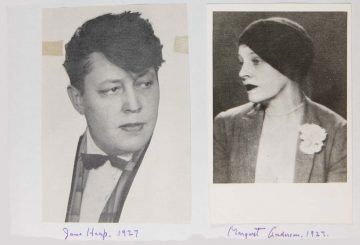Emma Garman in The Paris Review:
 In the early thirties, for a certain clique of Left Bank–dwelling American lesbians, the place to be was not an expat haunt like the Café de Flore or Le Deux Magots. Nor was it Le Monocle, the wildly popular nightclub owned by tuxedoed butch Lulu du Montparnasse and named for the accessory worn to signal one’s orientation. According to the writer Solita Solano, the “only important thing in Paris” was a study group on the philosophies of the Greek-Armenian mystic George Ivanovich Gurdjieff, held at Jane Heap’s apartment. Heap, a Kansas-born artist, writer, and gallerist, was Gurdjieff’s official emissary, a rare honor. Under her supervision, the group engaged in intense self-revelation, narrating the stories of their lives without censoring or embellishing. As the author Kathryn Hulme explained in her memoir, Undiscovered Country: A Spiritual Adventure, the goal was to uncover the real I and thus escape being “a helpless slave to circumstances, to whatever chameleon personality took the initiative.”
In the early thirties, for a certain clique of Left Bank–dwelling American lesbians, the place to be was not an expat haunt like the Café de Flore or Le Deux Magots. Nor was it Le Monocle, the wildly popular nightclub owned by tuxedoed butch Lulu du Montparnasse and named for the accessory worn to signal one’s orientation. According to the writer Solita Solano, the “only important thing in Paris” was a study group on the philosophies of the Greek-Armenian mystic George Ivanovich Gurdjieff, held at Jane Heap’s apartment. Heap, a Kansas-born artist, writer, and gallerist, was Gurdjieff’s official emissary, a rare honor. Under her supervision, the group engaged in intense self-revelation, narrating the stories of their lives without censoring or embellishing. As the author Kathryn Hulme explained in her memoir, Undiscovered Country: A Spiritual Adventure, the goal was to uncover the real I and thus escape being “a helpless slave to circumstances, to whatever chameleon personality took the initiative.”
Among those who gathered in Heap’s small sitting room were Janet Flanner, the New Yorker Paris correspondent and Solano’s lifelong partner; the journalist and author Djuna Barnes; and the actress Louise Davidson. One attendee, Hulme noted, would enter the room “like a Valkyrie” and “knew how to load the questions she fired at Jane, how to bait her to reveal more than perhaps was intended for beginners.” The Valkyrie was Margaret Caroline Anderson, founder of the trailblazing Little Review, with whom Heap had first encountered Gurdjieff in New York in the early twenties. Heap and Anderson, whose friendship outlasted a love affair and a professional partnership, were kindred geniuses with an exclusive affinity. When Barnes, after a fling with Heap, marveled at her “deep personal madness,” Anderson replied: “Deep personal knowledge—a supreme sanity.” Heap called Anderson “my blessed antagonistic complement.” Via their shared endeavors and the cross-pollination of their ideas—artistic, literary, and spiritual—these two remarkable women left an indelible imprint on avant-garde culture between the wars.
More here.
